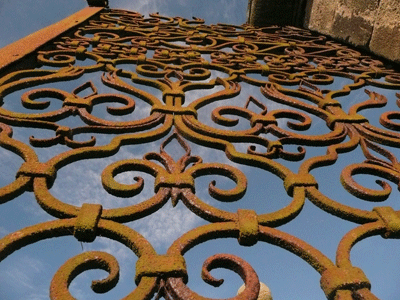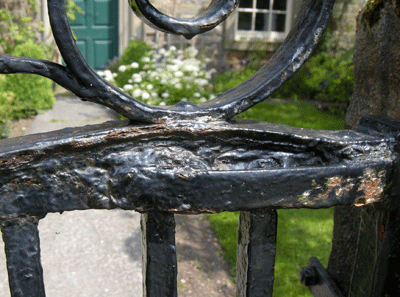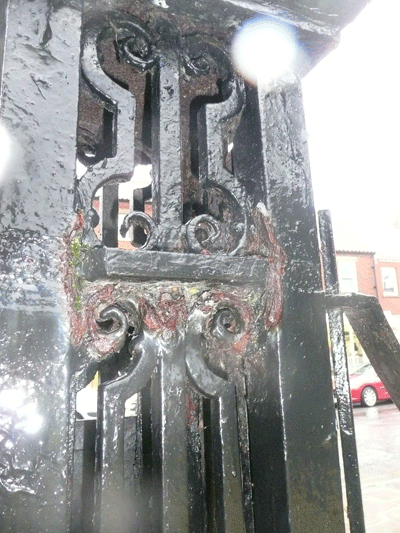How to maintain wrought ironwork
Wrought ironwork dates back as far as the Romans and, properly maintained, is a wonderful way of marking your boundaries

Everyone is familiar with wrought ironwork. I once asked some children on a workshop visit what they understood by the term ‘wrought iron' and the reply was "It's black and it's cheap"! This is the kind of image blacksmiths have to put up with.
The term ‘wrought iron', nowadays often used in just the way the children understood, also covers a wonderful branch of craftsmanship that many would categorise as Art. Although it has a pedigree stretching back to the Romans, wrought iron flowered in Britain at the beginning of the eighteenth century, the ‘Golden Age', which gave us the great gates to the stately homes and palaces. Many of these are now three hundred years old and it is a tribute to the skill of the old smiths, and to the materials they used, that the ironwork has lasted so long. However, there is some maintenance involved!
Iron, in its common modern form of mild steel, is well known for its desire to oxidise just as quickly as it can. Car bodies, garden furniture and modern wrought ironwork all need a good deal of maintenance to keep them free of rust, so much so that it's automatic nowadays for steelwork which is to last outdoors to be galvanised. There was no such protection given to the old ironwork.
Old metalwork is usually made from either cast iron - familiar from the Victorian period - or a metal known as ‘wrought iron', which is unlike modern materials in that the primitive refining techniques of the time did not remove the impurities but included them in the matrix of the metal in the form of fibres of glassy slags. These slags are similar to glass, and as a result add a measure of protection to the iron. Any non-cast item from before 1914 is likely to be wrought iron, and with reasonable maintenance, can be made to last indefinitely.
Wrought iron is commonly covered in paint (please don't paint it black) but there are many familiar examples where this is not the case. Very often on country roads you will see rusty looking estate type railings which are often a hundred years old, and just as often still doing a good job. Painting wrought iron improves its appearance, but unless the paint film is maintained, does not necessarily protect. When the paint film starts to deteriorate it can trap moisture close to the iron surface, resulting in corrosion. Similarly, if there is a build-up of rust scale in a water trap, the scale itself can trap moisture against the surface and make the problem worse.

Unpainted ironwork showing rust build-up only in water traps
Ultimately this can result in complete perforation of the iron or distortion where, for example, the rust scale builds up between two adjacent pieces of iron.
Exquisite houses, the beauty of Nature, and how to get the most from your life, straight to your inbox.

Distortion due to rust jacking
The first stage in maintenance therefore is to remove any damaged paintwork and to get rid of any rust scale. This may not be easy to chip away in awkward places - wear safety glasses - and it may be best to apply heat to the area to release the scale. When you heat iron it expands. Rust scale doesn't, so the expanding iron will release the scale, which then needs to be chipped or wire brushed to remove it from the area. For lightweight components a blowlamp will do if it is powerful enough to get the iron nearly red hot, or for more serious work an oxy-propane torch will be needed and this may well be the time to get in a specialist blacksmith. In many instances the rust will be between adjoining members and it may be possible to do some dismantling to get at it.

Rust built-up in corners
As stated above, the corrosion will be halted or at least discouraged simply by exposing the real surface of the iron to the air, but usually this won't be the end of it and a paint system will be required. Don't be tempted by exotic paints. All paint systems are more or less porous, and one day it will be necessary to remove the paint again to do maintenance, so the accent is on reversibility and the old oil-based systems are the best. Use a good zinc-rich primer followed by two coats for thickness - micaceous iron oxide is good - and a gloss or satin top coat for appearance. Apply the paint with a brush and stipple it well into every crack. The idea is to make the water run off. Places where water will gather, such as the bases of groups of leaves, can be filled with a liquid resin prior to the application of the final coats of paint.
Founded in 1980 Chris Topp & Co Ltd is based in North Yorkshire and is the only producer in the world today of genuine wrought iron and a leader in the restoration of heritage ironwork. They are one of the best known names for the design and creative production of modern and traditional iron work. Chris is also chairman of the National Heritage Ironwork Group (NHIG) which is dedicated to safeguarding and preserving wrought ironwork, by promoting high standards of workmanship, conservation and repair.
** National Heritage Ironwork Group

Country Life is unlike any other magazine: the only glossy weekly on the newsstand and the only magazine that has been guest-edited by His Majesty The King not once, but twice. It is a celebration of modern rural life and all its diverse joys and pleasures — that was first published in Queen Victoria's Diamond Jubilee year. Our eclectic mixture of witty and informative content — from the most up-to-date property news and commentary and a coveted glimpse inside some of the UK's best houses and gardens, to gardening, the arts and interior design, written by experts in their field — still cannot be found in print or online, anywhere else.
